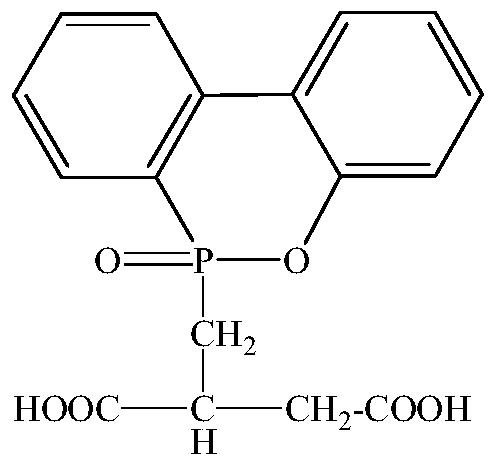Permanent flame retardant nylon 6 material and preparation method thereof
A flame-retardant nylon, permanent technology, applied in the field of flame-retardant nylon synthesis, can solve the problems of small impact on performance, monotonous melting point, loss of fabric strength, etc. little effect
- Summary
- Abstract
- Description
- Claims
- Application Information
AI Technical Summary
Problems solved by technology
Method used
Image
Examples
Embodiment 1
[0036] A preparation method of a permanent flame-retardant nylon 6 material, specifically comprising the following steps:
[0037] (1) Mix the flame retardant DDP, hexamethylenediamine and water, mix evenly at 50°C for 2 hours under the protection of nitrogen, then stir and react at 90°C for 2 hours, then raise the temperature to 150°C for further polymerization, and finally decompress and vacuumize, and react Finish generating flame retardant prepolymer, it is viscous liquid, number average molecular weight Mn is 1.8×10 3 , the molar ratio of flame retardant DDP, hexamethylenediamine and water is 1:1.1:2, and the two ends of the obtained flame retardant prepolymer are active end groups of a carboxyl group and an amine group respectively;
[0038] The structure of the flame retardant is:
[0039]
[0040] (2) 90.7 parts by mass of caprolactam, 4.0 parts by mass of water and 0.3 parts by mass of adipic acid are added to the reactor, and N 2 Exhaust the air in the kettle, s...
Embodiment 2
[0049] A preparation method of a permanent flame-retardant nylon 6 material, specifically comprising the following steps:
[0050] (1) Mix the flame retardant CEPPA, hexamethylenediamine and water, mix evenly at 80°C for 3 hours under the protection of nitrogen, then stir and react at 130°C for 3 hours, then raise the temperature to 180°C for further polymerization, and finally decompress and vacuumize, react Finish generating flame retardant prepolymer, it is semi-solid, number average molecular weight Mn is 2.5 * 10 3 , the molar ratio of flame retardant CEPPA, hexamethylenediamine and water is 1:1.2:2.5, and the two ends of the obtained flame retardant prepolymer are respectively a carboxyl group and an amine active end group;
[0051] The structure of the flame retardant is:
[0052]
[0053] (2) 84.0 parts by mass of caprolactam, 5 parts by mass of water and 1 part by mass of adipic acid are added to the reactor, and N 2 Exhaust the air in the kettle, stir at a speed...
Embodiment 3
[0062] A preparation method of a permanent flame-retardant nylon 6 material, specifically comprising the following steps:
[0063] (1) Mix the flame retardant BCPPO, hexamethylenediamine and water, mix evenly at 60°C for 2.5 hours under the protection of nitrogen, then stir and react at 95°C for 2 hours, then raise the temperature to 160°C for further polymerization, and finally vacuumize under reduced pressure, At the end of the reaction, a flame retardant prepolymer is generated, which is a viscous liquid with a number average molecular weight Mn of 2.8×10 3 , the molar ratio of flame retardant BCPPO, hexamethylenediamine and water is 1:1.2:2.1, and the two ends of the obtained flame retardant prepolymer are respectively a carboxyl group and an amine active end group;
[0064] The structure of the flame retardant is:
[0065]
[0066] (2) 92.9 parts by mass of caprolactam, 0.8 parts by mass of water and 0.8 parts by mass of adipic acid are added to the reactor, and N 2 ...
PUM
| Property | Measurement | Unit |
|---|---|---|
| melting point | aaaaa | aaaaa |
| tensile strength | aaaaa | aaaaa |
| melting point | aaaaa | aaaaa |
Abstract
Description
Claims
Application Information
 Login to View More
Login to View More - R&D
- Intellectual Property
- Life Sciences
- Materials
- Tech Scout
- Unparalleled Data Quality
- Higher Quality Content
- 60% Fewer Hallucinations
Browse by: Latest US Patents, China's latest patents, Technical Efficacy Thesaurus, Application Domain, Technology Topic, Popular Technical Reports.
© 2025 PatSnap. All rights reserved.Legal|Privacy policy|Modern Slavery Act Transparency Statement|Sitemap|About US| Contact US: help@patsnap.com



